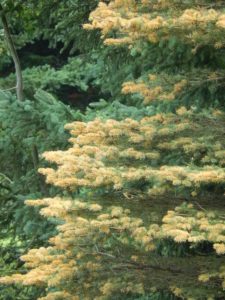By Linda Williams, forest health specialist, Woodruff, Linda.Williams@wisconsin.gov, 920-360-0665
Spruce needle rust is showing up in some northern counties. This rust fungus infects current year needles of most spruce species, including white and black spruce, with blue spruce being most severely impacted.

Spore-producing structures of the fungus emerging from infected spruce needles.
Spruce needle rust can be identified by pustules, ranging in color from pink to orange, that erupt from the needles in mid- to late-summer. Many pustules will erupt from each infected needle, and when multiple needles on a branch are infected, the tree can take on a pink or orange hue from a distance.

Trees with severe needle rust infections appear pink, yellow or white even from a distance.
Spruce needle rust seems to be a regularly occurring issue in the north that generally doesn’t cause much damage. Since only a percentage of needles on a branch are impacted and drop off early, there should be plenty of needles remaining on the tree. The tree may look a little thinner than normal after it drops those infected needles, but it won’t be severe enough to kill the tree even with repeated infections.
Note: this needle disease is different than Rhizosphaera needlecast on spruce, which can cause significant defoliation, tree decline and branch mortality when it occurs for multiple consecutive years. Minnesota DNR put together a wonderful document to help distinguish between various insect and disease issues on spruce.
